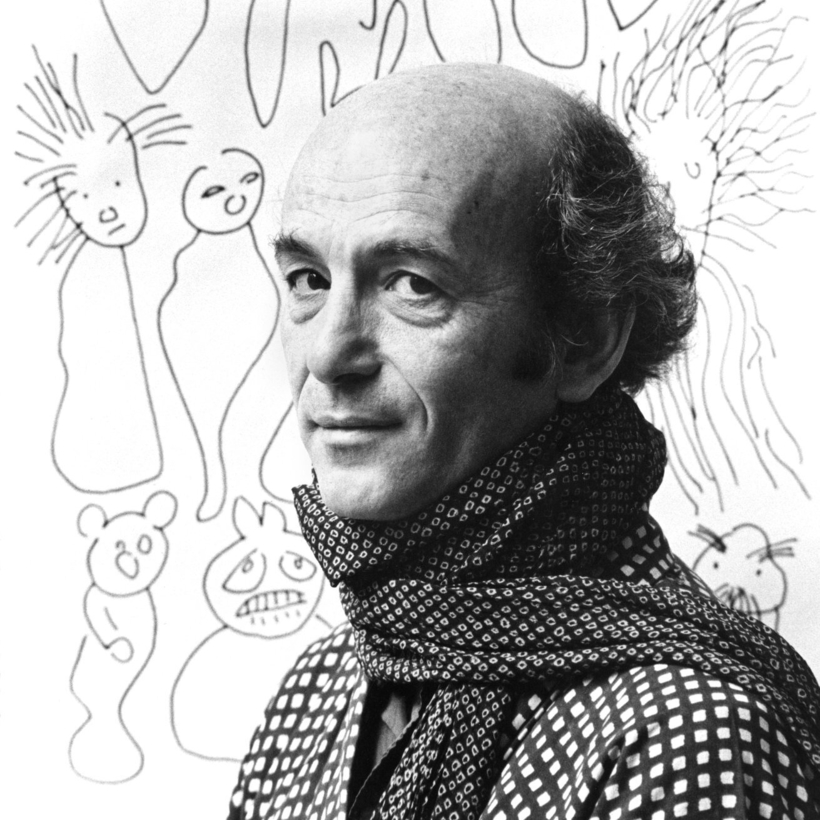In the fall of 1971, Nancy Lewis of the New York dance collective Grand Union received a postcard via airmail from her friend the choreographer and children’s author Remy Charlip. On one side was the 1926 André Kertész photograph Satiric Dancer, a picture of a buxom cabaret performer lounging suggestively on a couch. On the other side was a message. “This is the first position of the dance,” it read. “If you want more, call me collect in Paris and I’ll send you the rest of it.”
Previously, Lewis had asked Charlip, who was living in Paris, to choreograph a piece for her first solo show. “I said yes and fell back asleep,” Charlip recalled.
Sometime later, while traveling in Rotterdam, he ran into a mutual friend who also had a piece in Lewis’s program. “Then I remembered.” Here he was, 3,600 miles away with only two weeks to go, and the husband and wife who managed the Hell’s Kitchen theater where Lewis would be performing were not about to fly him over—an unfavorable position for a choreographer. Even in the avant-garde, you were expected to show up.

Fortunately, to use a phrase from Charlip’s beloved children’s book of that title, he could draw. After getting the go-ahead from Lewis to finish the dance, Charlip stayed up late into the night, diagramming a three-page letter that he sent in haste to her New York address. Following in the slipstream of his friend Ray Johnson’s mail art, “Instructions from Paris” arrived just in time for Lewis to include it in her show, Just Dancing, which opened on December 14, 1971, to favorable reviews.
Subsequent “Air Mail Dances” were dispatched to other dancers, with increasing postage, as far as South America (“Instructions to Caracas”) and Australia (“The Woolloomoolloo Cuddle”). Charlip distinguished these, which he sent to friends, from formal commissions, which he called “Mail Order Dances.”
The Air Mail Dance was created to solve a problem that now seems quaint, with new dances pinging around the world on TikTok millions of times per day at the speed of light. As an innovation, it is obsolete. But considered as artworks, the Air Mail Dances are alive with their maker’s irreverent trickster energy.

Charlip obeyed no known system of dance notation and showed little interest in codifying a new one. Position six of “Instructions from Paris” shows a woman holding a fish and a basket of flowers, another image taken from a French postcard. “Skip the basket, flowers & fish,” Charlip wrote. “Just do the position.” The turns, which he left up to the performer, were annotated “(God Only Knows).”
The Air Mail Dances are still performed, and Fortunately (1964) has never gone out of print. Three recent Caldecott medalists—Jon Klassen, Brian Selznick, and Lane Smith—cite Charlip as an influence. (Selznick used him as a live model for the French filmmaker Georges Méliès while drawing The Invention of Hugo Cabret.) He was not unrecognized.
Yet the two halves of Charlip’s prolific 50-year career in dance and children’s publishing have never quite added up to mainstream renown. Enthusiasts of his choreography tended to regard the picture books as a means of subsidizing his higher art, and Charlip’s readers were mostly too young to have frequented Caffé Cino or La MaMa.
The Air Mail Dances are still performed, and Fortunately (1964) has never gone out of print.
But the cult of Charlip is enjoying a revival. Four of his books have been reissued recently: Thirteen (1975), co-written and co-illustrated with Jerry Joyner, and Arm in Arm: A Collection of Connections, Endless Tales, Reiterations, and Other Echolalia (1969), by the New York Review Children’s Collection; and Dress Up and Let’s Have a Party (1956) and Where Is Everybody? (1957), by Enchanted Lion. A fifth, Sandol Stoddard Warburg’s My Very Own Special Particular Private and Personal Cat, which Charlip illustrated, is forthcoming, also from Enchanted Lion.

Unlike Dr. Seuss or Eric Carle, Charlip never settled into a signature style. He preferred to let the idea dictate the level of detail, the palette, and the design. Fortunately goes from black-and-white to color and back each time its protagonist has a change of luck. Mother Mother I Feel Sick Send for the Doctor Quick Quick Quick (1966), co-written with Burton Supree, is told through silhouettes, like a shadow play. In Margaret Wise Brown’s Four Fur Feet (1961), Charlip instructs the reader to rotate the book as a nameless quadruped makes its way around the world.
A Free Spirit
Abraham Remy Charlip was born in 1929 to Lithuanian-immigrant parents and grew up in Brooklyn. His early training in the graphic arts at Straubenmuller Textile High School and Cooper Union ensured that he never had to starve for his art, which became a real possibility once Charlip decided to become a dancer. “I thought dancers were free spirits. The one way I could be a free spirit was to study dance,” he said. “Little did I know how tyrannical and puritanical they were.”
In 1949, Charlip received a scholarship to a summer program taught by a former Martha Graham dancer at Reed College in Portland, Oregon. He arrived on a Sunday, at a seemingly empty campus, and according to one source began “calling up to windows at random,” prompting a young composer named Lou Harrison to look out onto the quad with a facefull of shaving cream. (They soon became a couple.) It’s only fitting that Charlip’s first encounter with the man who went on to introduce him to John Cage and Merce Cunningham, two artists who dared to embrace the variable of chance, should have come about with a roll of the cosmic dice.
Over the next few years, Charlip spent several seasons at Black Mountain College in Asheville, North Carolina. In the summer of 1952, Cage put on a performance in the school’s dining hall that featured a lecture, an art exhibition, a poetry reading, a concert, a film, and an improvised dance—all at once. (Like the Beatles’ White Album, it was technically untitled but came to be known as “Theater Piece No. 1,” or simply “The Event,” and is now seen as the prototype for the multimedia “happenings” of the 1960s.) Charlip, using tweezers to set the type, printed programs on rolling paper and placed one on each seat, with an ashtray and a little loose tobacco; by design, they all went up in smoke.
A founding member of the Merce Cunningham Dance Company, Charlip remained with the group for more than a decade, not just performing but also designing costumes, props, and flyers. “Merce and John became substitute family and had an almost parental authority for Remy,” his friend and fellow company member Carolyn Brown observed in her 2007 memoir, and the evidence is everywhere in Charlip’s work. A child’s newspaper hat in Betty Miles’s What Is the World? (1958), which Charlip illustrated, is made from a clipped Village Voice review of a Cunningham performance. It Looks Like Snow (1957), a limited-run book that consisted of 24 unadorned pages, was dedicated for obvious reasons to Cage. (“If you look closely, you will see that it’s snowing … ,” the text explains.)

But practically speaking, it was every man for himself. “There was going to be no way for any of us to make a living dancing with Merce,” Brown wrote. By becoming a children’s author, Charlip was “able to solve the problem in a way that was both creatively and financially rewarding,” and, as she points out, “not physically taxing.”
Initially, Cunningham was supportive. He even witnessed the contract for Dress Up and Let’s Have a Party. But at some point, Cunningham decided that Charlip was spending too much time on other projects, and in 1961 he fired him over the phone. It was a painful break for Charlip but, considering all that he would go on to produce, a necessary one.
In 1989, Charlip left New York for San Francisco, where he became a father figure—or “gay uncle,” per the city’s underground LGBTQ weekly—to a number of young Bay Area artists. His own father had been an abusive alcoholic, he later told a writer for The Advocate. When Charlip suffered a stroke in 2005, his new friends took turns caring for him. A benefit was held the following year to crowdfund his medical bills and pay homage. Charlip had recovered enough by that point to perform a new piece inspired by the Alexander Technique, an alternative physical therapy that his friends had used to partially rehabilitate him. He died in 2012 at the San Francisco Zen Hospice.

One morning years earlier, Charlip had woken up paralyzed with fear. He had to film a segment for Boston’s WGBH, and he knew he wouldn’t have time to rehearse. To get himself moving again, he did a piece of his own called “The Bed Dance,” right where he was. “And then I thought, now I’ll do a ‘Getting Out of the Bed Dance.’ And now I’ll do a ‘Taking a Shower Dance,’” all the way through “a ‘Going Out of the House Dance.’ And so, I danced my way all the way through the day,” he said. “Now I don’t think of dancing as separate from my life.” (“Right now, you are performing a Reading this Writing Dance,” his Web site says.)
This new outlook found its fullest expression in 1987, when the Joyce Theater in New York staged an evening of his work, titled Remy Charlip Dances. It commenced with an announcement. “Owing to circumstances beyond our control, all the sets, costumes … and dancers … have been lost in transit,” a bespectacled man in a dinner jacket informed the audience before going on to narrate, in a plummy British accent, “what at the moment will have to remain ‘Ten Imaginary Dances.’”
“Waiting dance,” he read. “Curtain rises. Any number of people on stage. All waiting. For as long as they want to. Curtain closes.” Then there was “Sardines”: “Eight boys and girls undress and get into a bathtub. After the last one gets in, the choreographer pours a huge can of warm olive oil all over them. They arrange themselves comfortably. Curtain.”
Charlip titled the last number in the suite “Revolutionary Dance No. 1.” “We all go into the Joyce Theater on 8th Avenue to see this performance,” it began. “At the end of the performance, when we all go out, 8th Avenue is not 8th Avenue anymore. We are on a tropical island, standing on a clear white beach looking over the water, watching a magnificent sunset.”
Ash Carter is the Features Editor of Air Mail and the co-author of Life Isn’t Everything: Mike Nichols as Remembered by 150 of His Closest Friends

